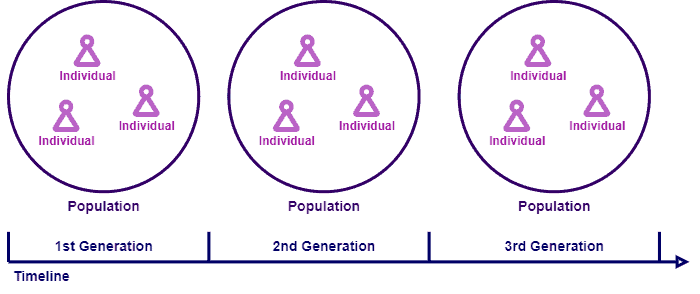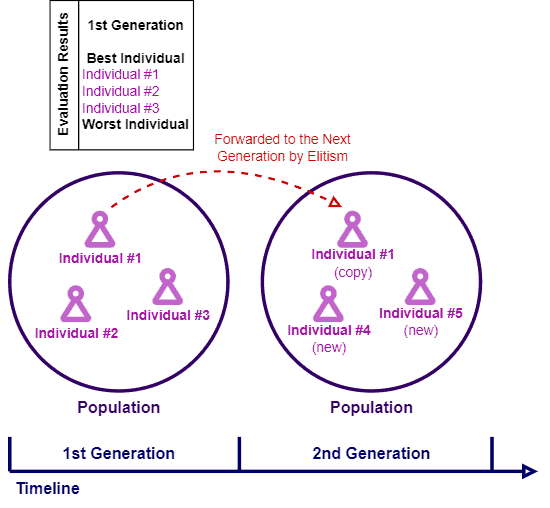1. 引言
本文我们将探讨进化算法(Evolutionary Algorithms)中的一个关键概念——精英主义(Elitism)。我们将先简要回顾进化算法的背景知识,再介绍其核心组成元素,最后深入讲解精英主义的定义、作用、配置方式及其优缺点。
2. 进化算法背景
在现实生活中,我们常常面临各种优化问题(Optimization Problems),例如经典的旅行商问题(TSP)。这类问题的目标是找到一个最优或近似最优解。
解决优化问题的算法大致可分为两类:
- ✅ 精确算法(Exact Algorithms):能保证找到最优解,但计算复杂度高,如暴力穷举法
- ✅ 近似算法(Approximate Algorithms):无法保证找到最优解,但计算效率高,常用于大规模问题,例如启发式(Heuristics)和元启发式(Metaheuristics)算法
进化算法属于元启发式算法的一种,其灵感来源于自然界中的演化机制,是生物启发计算(Bio-inspired Computing)的重要组成部分。
其中最著名的进化算法之一是遗传算法(Genetic Algorithms),它借鉴达尔文进化论的思想,通过选择、交叉和变异等机制来优化问题。其他常见类型还包括差分进化(Differential Evolution)、神经进化(Neuroevolution)和学习分类系统(Learning Classifier Systems)等。
3. 进化算法中的关键概念
要理解精英主义,我们先来了解进化算法中的几个核心元素:
- ✅ 个体(Individual):代表问题的一个可能解。例如在TSP问题中,个体可以是一条路径
- ✅ 种群(Population):当前一代中所有个体的集合,即当前考虑的解集
- ✅ 代(Generation):某一轮进化过程中产生的种群。随着代数的增加,解的质量通常会逐步提升
下图展示了这些概念之间的关系:

此外,进化算法中常见的两个操作是:
- ✅ 交叉(Crossover):通过两个或多个个体组合生成新个体
- ✅ 变异(Mutation):对个体进行随机修改,以探索新的解空间
这些机制是推动种群进化的关键驱动力。
4. 精英主义(Elitism)
精英主义的核心思想是保留当前种群中最优的个体,确保其在后续代中继续发挥作用。
具体来说,精英主义通常表现为以下两种形式之一:
- ✅ 将当前代中表现最好的一个或多个个体直接保留到下一代
- ✅ 在交叉过程中,强制将最优个体与其它个体配对,以提高其对下一代的影响
使用精英主义的前提是:先对当前代个体进行评估,找出最优解。评估通常基于一个目标函数(Objective Function)的值。
4.1 精英主义的作用
- ✅ 保留最优解:防止在进化过程中丢失当前最优解
- ✅ 加速收敛:引导算法更快地向优质解空间靠近
- ✅ 提升稳定性:确保最终输出的解是整个进化过程中找到的最优者
下图展示了精英主义在多代进化中的作用:

4.2 精英主义的配置
虽然精英主义有助于提升算法表现,但过度使用会导致种群多样性下降,从而降低算法的全局搜索能力。
因此,通常只保留种群中一小部分个体作为精英。常见的配置方式包括:
- ✅ 精英数量为种群总数的10%
- ✅ 精英中的前50%直接保留到下一代
- ✅ 精英中的后50%与非精英个体进行交叉
⚠️ 注意:精英数量和策略应根据具体问题进行调整,没有统一的“最佳配置”。
此外,是否使用精英主义也应视问题而定。在某些需要更强探索能力的场景中,可能不使用精英主义。
5. 总结
本文我们介绍了进化算法中的精英主义(Elitism)机制。通过保留最优个体,精英主义可以有效防止优质解的丢失,加速算法收敛,并提升最终结果的质量。
但同时,精英主义也可能导致种群多样性下降,影响算法的探索能力。因此,在实际应用中,需要根据问题特性合理配置精英比例和使用策略。
✅ 总结一句话:
精英主义是一把双刃剑,合理使用可以显著提升进化算法的性能,但滥用则可能导致过早收敛。